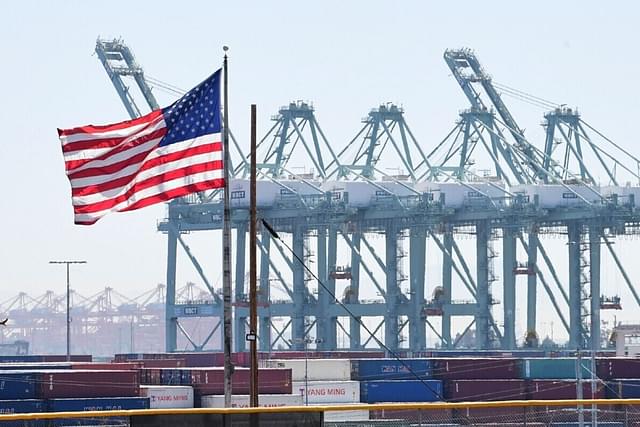World
Why America Is Investing Billions To Replace China-Made Cranes At Its Ports
Amit Mishra
Feb 22, 2024, 03:09 PM | Updated 03:29 PM IST
Save & read from anywhere!
Bookmark stories for easy access on any device or the Swarajya app.

President Joe Biden signed an executive order on Wednesday (21 February) directing an investment of over $20 billion over the next five years to improve the United States (US) port infrastructure, including domestic manufacturing of port cranes.
The move to onshore American crane manufacturing emerges from apprehensions surrounding the potential for Beijing to remotely operate these cranes, thus disrupting the trade flow.
At issue is the fact that nearly 80 per cent of the ship-to-shore cranes used at US ports are made by state-owned Shanghai Zhenhua Heavy Industries (ZPMC) in China, a fact corroborated by Rear Admiral Jay Vann, commander of the United States Coast Guard Cyber Command.
ZPMC entered the US market around two decades ago and has since become a dominant force, largely due to its state-owned status, which enables it to offer competitive prices without profit pressure.
While the American Coast Guard has scrutinised the cybersecurity of 92 Chinese-made cranes out of the “over 200” installed at American ports, no public red flags have been raised thus far.
Yet, concerns about Chinese-made cranes infiltrating American ports and potentially gathering intelligence on US military or business logistics have been raised by Pentagon officials before.
According to a March 2023 report in the Wall Street Journal (WSJ), these cranes contain "sophisticated sensors that can register and track the provenance and destination of containers."
The newspaper said this could enable Chinese officials to "capture information about material being shipped in or out of US to military operations around the world," and to try to disrupt trade.
In fact, Bill Evanina, a former top US counterintelligence official, said “Cranes can be the new Huawei,” referring to the Chinese telecom giant Huawei, whose equipment have faced international bans over espionage apprehensions.
Since then, leading lawmakers in the US Congress have sought to highlight the Chinese influence on port infrastructure. In May 2023, a bill titled 'Port Crane Security and Inspection Act of 2023' was proposed in the House of Representatives that sought to bar the use of foreign cranes in US ports, while also requiring a security review of all existing cranes.
However, the American Association of Port Authorities, which lobbies on behalf of the nation’s major container ports, has consistently underscored that despite the "sensationalised claims," there is no substantiated evidence of cranes being utilised to disrupt or surveil port operations.
Given the gargantuan economic stakes — exceeding $5.4 trillion in economic activity and over 90 per cent of overseas trade coursing through its ports — any cyberattack could disrupt not only US military operations, but also vital supplies like food and fuel essential for everyday Americans.
Against this backdrop, Wednesday's executive order provides a significant boost to reduce port industry’s over-reliance on Chinese cranes.
The funding allocated for port infrastructure will support Paceco Corp, a US subsidiary of the Japanese firm Mitsui, to produce domestic cargo cranes, the White House said on Wednesday.
Originally operating as Paceco Inc., Paceco manufactured the first ship-to-shore dedicated container crane in 1958 that helped drive the shipping industry’s move to containerisation and sustained US-based crane manufacturing until the late 1980s.
The company intends to partner with other experienced manufacturing companies to bring port crane manufacturing capabilities back to the US after three decades, pending final site and partner selection.
Meanwhile, the Chinese embassy in Washington has brushed off US crane concerns as "paranoia-driven," portraying them as an attempt to hinder bilateral trade and economic collaboration.
While playing the 'China card' to strengthen domestic manufacturing may align with the Biden administration’s goal of revitalising US industry, it is likely to heighten geopolitical tensions between Washington and Beijing.
Closer to home, India finds itself compelled to reassess the presence of Chinese-manufactured cranes within its own ports, cognisant of the far-reaching implications on national security and economic sovereignty.
Also Read: Dragon In The Ports: Why India Needs To Cultivate Homegrown Expertise For Mega Cranes
Save & read from anywhere!
Bookmark stories for easy access on any device or the Swarajya app.
Support Swarajya's 50 Ground Reports Project & Sponsor A Story
Every general election Swarajya does a 50 ground reports project.
Aimed only at serious readers and those who appreciate the nuances of political undercurrents, the project provides a sense of India's electoral landscape. As you know, these reports are produced after considerable investment of travel, time and effort on the ground.
This time too we've kicked off the project in style and have covered over 30 constituencies already. If you're someone who appreciates such work and have enjoyed our coverage please consider sponsoring a ground report for just Rs 2999 to Rs 19,999 - it goes a long way in helping us produce more quality reportage.
You can also back this project by becoming a subscriber for as little as Rs 999 - so do click on this links and choose a plan that suits you and back us.
Click below to contribute.





